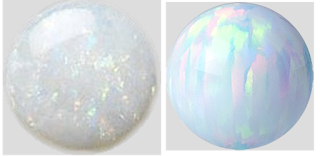When purchasing jewelry you will often come across items that are described with unfamiliar terms. Here is the short list of what all jewelry lovers should really know.
AB - aurora borealis
 |
| Ab finish on Czech Glass and Swarovski Crystal |
(D)- dyed.
 |
| Dyed agate beads |
While all manner of dyes may be used on gemstones not all are stable and can bleed or fade if they come into contact with water, sweat, chemical solvents or sunlight. Testing in an inconspicious location is prudent when purchasing gemstones that have been treated with dyes.
(S) or (Syn)- synthetic
An artificial gemstone made by labratory means identical to those formed naturally and with the same chemical component as its genuine counterpart. It is very difficult to tell these synthetic stones from the genuine ones for this reason. Often the only way to distinguish is due to the fact that synthetic gemstones have no flaws while genuine stones will almost always have inclusions, flaws or other imperfections. |
| Natural Opal Synthetic Opal |
The most common synthetic gemstones include malachite, opal, spinel, alexandrite, chrysoberyl, garnet, aquamarine, red and yellow beryl, sapphire, ruby, emerald, turquoise, and more recently, diamonds. Synthetic quartz is also made for watches and other technological uses.
 |
| Genuine Chalk Turquoise |
Chalk Turquoise
Chalk turquoise is genuine turquoise that has a mohs hardness of 2-4 rather mohs 6 which is found in higher grades of turquoise. While it can contain some veining like higher grades its coloration is different being a light clear blue or even white.It easily holds dye due to its softness. And this is often the case with this stone. Stabilizers, waxes and other products may be used to harden the stone, as well. It should be noted that many items called chalk turquoise are, in fact, howlite or another soft stone that has been dyed a turquoise color.
 |
| True Filigree Work |
Filigree, filagrene, filagran or filagree
Originally filigree was created by soldering small pieces of flattened and twisted wires to form lacy shapes. These shapes sometimes included small beads or lumps of solder to create texture. While this time-consuming process is still used today, during the industrial revolution machinery was created that could stamp out pieces from flat thinned metal sheets. While these are not technically true filigree it is what is often sold in modern jewelry as such. |
| Stamped Filigree Finding |


No comments :
Post a Comment
Please tell me what you think! :)